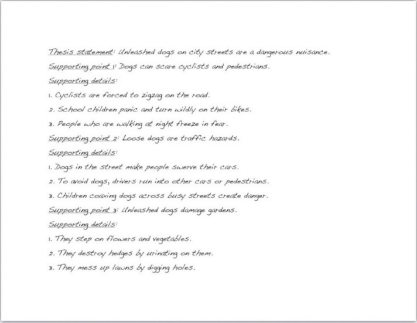4.5: Writing Body Paragraphs
- Page ID
- 50942
Learning Objectives
- Select primary support related to your thesis.
- Support your topic sentences.
- Providing connections between thesis and body paragraphs.
If your thesis and outline give the reader a roadmap to your essay, then body paragraphs should closely follow that map. The reader should be able to predict what follows your introductory paragraph by simply reading the thesis statement. Using transition words helps in connecting ideas for your reader and creates coherence. See Chapter 5 for chart of effective transitions.
The body paragraphs present the evidence you have gathered to confirm your thesis. Before you begin to support your thesis in the body, you must find information from a variety of sources that support and give credit to what you are trying to prove.
Primary Support for Your Thesis
Without primary support, your argument is not likely to be convincing. Primary support can be described as the major points you choose to expand on your thesis. It is the most important information you select to argue for your point of view. Each point you choose will be incorporated into the topic sentence for each body paragraph you write. Your primary supporting points are further supported by supporting details within the paragraphs.
Identify the Characteristics of Good Primary Support
In order to fulfill the requirements of good primary support, the information you choose must meet the following standards:
- Be specific. The main points you make about your thesis and the examples you use to expand on those points need to be specific. Use specific examples to provide the evidence and to build upon your general ideas. These types of examples give your reader something narrow to focus on, and if used properly, they leave little doubt about your claim. General examples, while they convey the necessary information, are not nearly as compelling or useful in writing because they are too obvious and typical.
- Be relevant to the thesis. Primary support is considered strong when it relates directly to the thesis. Primary support should show, explain, or prove your main argument without delving into irrelevant details. When faced with lots of information that could be used to prove your thesis, you may think you need to include it all in your body paragraphs. But effective writers resist the temptation to lose focus. Choose your examples wisely by making sure they directly connect to your thesis.
- Be detailed. Remember that your thesis, while specific, should not be very detailed. The body paragraphs are where you develop the discussion that a thorough essay requires. Using detailed support shows readers that you have considered all the facts and chosen only the most precise details to enhance your point of view.
Prewrite to Identify Primary Supporting Points for a Thesis Statement
Recall that when you prewrite you essentially make a list of examples or reasons why you support your stance. Stemming from each point, you further provide details to support those reasons. After prewriting, you are then able to look back at the information and choose the most compelling pieces you will use in your body paragraphs.
Exercise \(\PageIndex{1}\):
Choose one of the following working thesis statements. On a separate sheet of paper, write for at least five minutes using one of the prewriting techniques you learned in this chapter.
- Unleashed dogs on city streets are a dangerous nuisance.
- Students cheat for many different reasons.
- Drug use among teens and young adults is a problem.
- The most important change that should occur at my college or university is _________.
Select the Most Effective Primary Supporting Points for a Thesis Statement
After you have prewritten about your working thesis statement, you may have generated a lot of information, which may be edited out later. Remember that your primary support must be relevant to your thesis. Remind yourself of your main argument, and delete any ideas that do not directly relate to it. Omitting unrelated ideas ensures that you will use only the most convincing information in your body paragraphs. Choose at least three of only the most compelling points. These will serve as the topic sentences for your body paragraphs.
Exercise \(\PageIndex{2}\):
Refer to the previous exercise and select three of your most compelling reasons to support the thesis statement. Remember that the points you choose must be specific and relevant to the thesis. The statements you choose will be your primary support points, and you will later incorporate them into the topic sentences for the body paragraphs. You may also choose to outline your reasons, as part of your pre-writing.
Using Evidence to Support Your Thesis
When you support your thesis, you are revealing evidence. Evidence includes anything that can help support your stance. The following are the kinds of evidence you will encounter as you conduct your research:
- Facts. Facts are the best kind of evidence to use because they often cannot be disputed. They can support your stance by providing background information on or a solid foundation for your point of view. However, some facts may still need explanation. For example, the sentence “The most populated state in the United States is California” is a pure fact, but it may require some explanation to make it relevant to your specific argument.
- Judgments. Judgments are conclusions drawn from the given facts. Judgments are more credible than opinions because they are founded upon careful reasoning and examination of a topic.
- Testimony. Testimony consists of direct quotations from either an eyewitness or an expert witness. An eyewitness is someone who has direct experience with a subject; he adds authenticity to an argument based on facts. An expert witness is a person who has extensive experience with a topic. This person studies the facts and provides commentary based on either facts or judgments, or both. An expert witness adds authority and credibility to an argument.
- Personal observation. Personal observation is similar to testimony, but personal observation consists of your testimony. It reflects what you know to be true because you have experiences and have formed either opinions or judgments about them. For instance, if you are one of five children and your thesis states that being part of a large family is beneficial to a child’s social development, you could use your own experience to support your thesis.
Choose Supporting Topic Sentences
Each body paragraph contains a topic sentence that states one aspect of your thesis and then expands upon it. Like the thesis statement, each topic sentence should be specific and supported by concrete details, facts, or explanations.
Each body paragraph should comprise the following elements:
topic sentence + supporting details (examples, reasons, or arguments)
As you read earlier, topic sentences indicate the location and main points of the basic arguments of your essay. These sentences are vital to writing your body ragraphs because they always refer back to and support your thesis statement. Topic sentences are linked to the ideas you have introduced in your thesis, thus reminding readers what your essay is about. A paragraph without a clearly identified topic sentence may be unclear and scattered, just like an essay without a thesis statement.
Tip
Unless your teacher instructs otherwise, you should include at least three body paragraphs in your essay. A five-paragraph essay, including the introduction and conclusion, is commonly the standard for exams and essay assignments. It is not, however, the only format for an academic essay. It is, perhaps, the most familiar one.
Draft Supporting Detail Sentences for Each Primary Support Sentence
After deciding which primary support points you will use as your topic sentences, you must add details to clarify and demonstrate each of those points. These supporting details provide examples, facts, or evidence that support the topic sentence.
The writer drafts possible supporting detail sentences for each primary support sentence based on the thesis statement:

Tip
You have the option of writing your topic sentences in one of three ways. You can state it at thebeginning of the body paragraph, or at the end of the paragraph, or you do not have to write it at all. This is called an implied topic sentence. An implied topic sentence lets readers form the main idea for themselves. For beginning writers, it is best to not use implied topic sentences because it makes it harder to focus your writing. Your instructor may also want to clearly identify the sentences that support your thesis.
Print out the first draft of your essay and use a highlighter to mark your topic sentences in the body paragraphs. Make sure they are clearly stated and accurately present your paragraphs, as well as accurately reflect your thesis. If your topic sentence contains information that does not exist in the rest of the paragraph, rewrite it to more accurately match the rest of the paragraph.
Key Takeaways
- Your body paragraphs should closely follow the path set forth by your thesis statement.
- Strong body paragraphs contain evidence that supports your thesis.
- Primary support comprises the most important points you use to support your thesis.
- Strong primary support is specific, detailed, and relevant to the thesis.
- Prewriting helps you determine your most compelling primary support.
- Evidence includes facts, judgments, testimony, and personal observation.
- Reliable sources may include newspapers, magazines, academic journals, books, encyclopedias, and firsthand testimony.
- A topic sentence presents one point of your thesis statement while the information in the rest of the paragraph supports that point.
- A body paragraph comprises a topic sentence plus supporting details.


